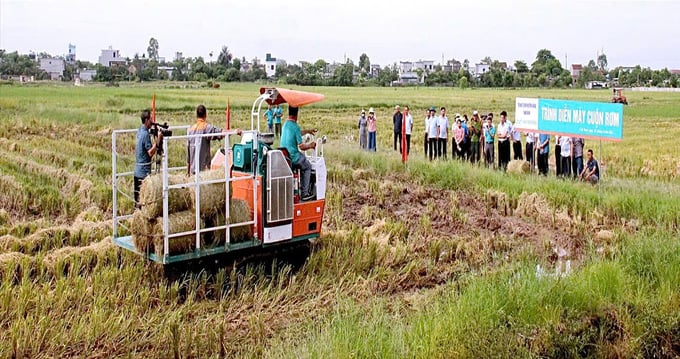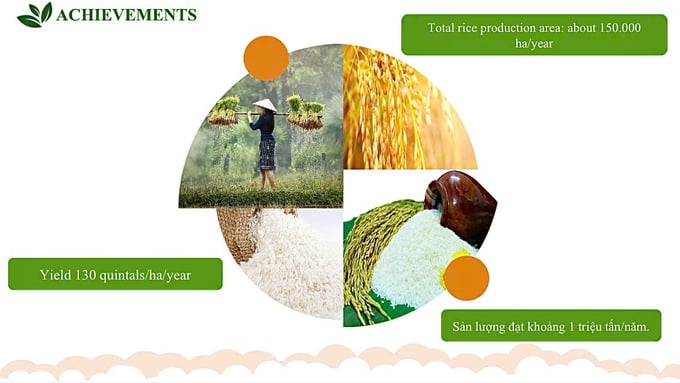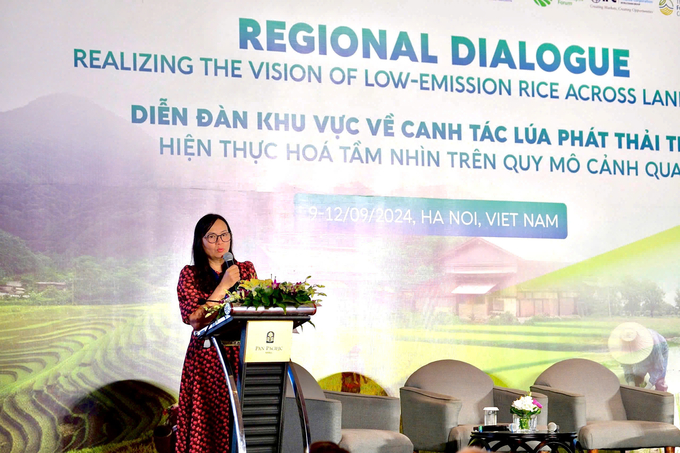November 27, 2025 | 20:33 GMT +7
November 27, 2025 | 20:33 GMT +7
Hotline: 0913.378.918
November 27, 2025 | 20:33 GMT +7
Hotline: 0913.378.918

Thai Binh is the second largest rice production province in the Red River Delta, with annual planted area of 150,000 ha.
Thai Binh is the second largest rice production province in the Red River Delta, with annual planted area of 150,000 ha. Thanks to its advantages in land, climate and water, Thai Binh can produce 2 rice cycles and 1 vegetable/subsidiary crop cycle. The province has always paid attention to technical advances, invested in irrigation and drainage infrastructure and upgraded on-farm transport system to facilitate production and trade and achieved the highest yield in the Red River Delta.

Thai Binh has always paid attention to technical advances, invested in irrigation and drainage infrastructure and upgraded on-farm transport system.
Specifically, regarding rice varieties: about 4.00% (6,000 ha) of the area is planted with rice varieties that have a growing period of 145-160 days (including both processing varieties and local traditional varieties); 96.00% of the area is planted with rice varieties that have a short growing period, with spring crops taking approximately 100-120 days and autumn crops taking about 90-110 days. In terms of seed quality: the entire planted area in Thai Binh province primarily uses certified seeds; the amount of seed used is about 28 kg to 35 kg/ha.
Fertilization is carried out using a cost-effective method, applying fertilizers according to the needs of the rice plants. The irrigation system meets the requirements for rice production, with proactive water management strategies based on the "Shallow-Wet-Dry" principle: maintaining shallow water during sowing, ensuring sufficient moisture during the tillering stage and draining the fields once the rice plants have fully tillered.

Thai Binh has successfully implemented the IPM and SRI programs, helping farmers reduce production costs and increase profits.
Additionally, Thai Binh has successfully implemented the IPM and SRI programs, helping farmers reduce production costs and increase profits. To date, 29 communes across the province, covering an area of 168.15 hectares, have been certified for Good Agricultural Practices (VietGAP); 263.95 hectares have been assigned planting area codes.
Mechanization in rice production and new models in rice cultivation have also been promoted. Currently, the province has 1,968 households with 2-5 ha of rice each, 4457 individuals with 5 ha of rice or more each, some households even have hundreds of ha each. The land accumulation for rice production facilitates investment in machines, equipment, synchronic mechanization from land preparation to harvesting and storage to ensure uniform yield and quality, utilize rice straw for production and export, and create favorable for alternate wet and dry irrigation.
Thai Binh now has about 200 rice milling facilities, including 170 household-size processing facilities; 20 companies and 40 cooperatives of medium and large size applying modern and automatic milling chains (Lien Hanh company ltd, Hung Cuc company ltd, Khang Long Food company ltd, Thai Binh Seed Group…). These all apply advanced quality management programs like ISO, food safety certification.
Rice-based processing activities in Thai Binh are very diverse. Specifically, automatic processing chain applied by Lien Hanh company to produce some products that meet standards for export; some traditional production villages producing some traditional products like noodle are located in Vu Hoi commune of Vu Thu district, and in Dong Xuan commune of Dong Hung district; rice paper mainly produced in Me village, ect. Thai Binh has also provided support and developed more than 35 rice brands like Lang Giang rice, Nep Keo rice, Cho Goc rice, Huong Viet 3 rice, organic Dai Thom 8 rice, 3 T rice…

Deputy Director of the Thai Binh Department of Agriculture and Rural Development, Nguyen Thi Nga, spoke at the regional forum on "Low-Emission Rice Cultivation" as part of the Folur Program. Photo: Quynh Chi.
However, Thai Binh Province is also facing several challenges, such as climate change, saltwater intrusion, and plant diseases, which pose significant threats to rice production in the future. Additionally, there is a shortage of labor in rice cultivation.
With its natural advantages and strong traditional cultivation practices, combined with the application of new scientific and technological advancements, Thai Binh Province will continue to expand the scale of household farming for rice production. This aims to guide farmers in reducing greenhouse gas emissions. The entire rice-growing area in the province will gradually adopt domestic and export-standard rice cultivation techniques. This includes implementing SRP, SRI, and IPHM standards for cultivation processes, to produce green agricultural products, protect the environment and work towards building and trading carbon credits in agriculture.

(VAN) According to Mr. Vo Minh Thanh, Director of the Tay Ninh Department of Agriculture and Environment, Resolution 57 has created a new development pathway for the locality, shifting from traditional toward modern agriculture.
/2025/11/26/4909-2-154329_878.jpg)
(VAN) Pearl grouper farming in HDPE cages not only delivers economic efficiency but also contributes to protecting the environment, creating jobs, and promoting marine-based experiential tourism.

(VAN) The model of making a living under the forest canopy through the agroforestry system in Van Son commune, Bac Ninh province, is expected to generate an annual income of approximately VND 30 million/ha.

(VAN) Many enterprises in Can Tho are harnessing natural energy and reducing greenhouse gas emissions in their production processes, thereby contributing to the promotion of a sustainable green transition.
/2025/11/24/3536-2-112800_176.jpg)
(VAN) Dong Nai now has tens of thousands of hectares of forests certified for sustainable management, and this area will continue to be expanded in the coming period.

(VAN) Vinh Ha hamlet (Dai Xuyen commune, Hanoi) is shifting away from small-scale farming as households adopt bioscurity into their breeder chicken models.

(VAN) Heavy rains make aquatic species more vulnerable to disease. Proactive water management and high-tech systems help farmers prevent outbreaks and protect yields.